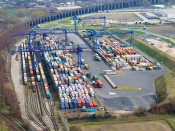
Companies look inland for improvement.
The third in a series of articles on how changes in port infrastructure and development can impact industrial real estate. The first article addressed the need for government authorities to prioritize spending on port infrastructure. The second article addressed the shifting role of rural river ports in communities. To read the previous article in this series, Rural River Ports Must Adapt To Stay Competitive, please click here.
The potential benefits from investing in inland port areas look promising. This is because inland ports are capable of meeting the needs of logistics services, manufacturers, and retailers who are continuously searching for ways to improve supply chain efficiency. By integrating inland ports into their networks, these stakeholders experience faster and less expensive ways to transport products to end users. As these stakeholders continue looking inland to take advantage of intermodal transportation networks to bypass congestion and high costs at major port areas, inland demand for warehousing and industrial facilities keeps growing.
Well positioned inland ports are more capable of adapting to demand as trade increases across the globe. The increase in the flow of goods congests the U.S. trade infrastructure and produces challenges for goods to get delivered quickly. This makes inland port locations in intermodal networks as well as the ports’ warehouses and industrial facilities that facilitate commerce crucial to successful relationships between inland ports and stakeholders. Industrial real estate space in proximity to ports connected in intermodal transportation networks will be needed to accommodate the needs of those handling ever-greater amounts transported goods.
According to JLL, 80% of distribution centers’ operating costs are attributable to logistics. Inland ports make transportation more efficient by getting products to consumers faster and at lower costs relative to traditional methods. The global supply chain has been shifting over the past several years due to changes in transportation methods and increased trade volume. Increases in trade continue to impact the demands for industrial real estate as larger buildings and increasing ceiling heights are required. This constrains the ability for coastal port areas to accommodate the needs of the market. Simultaneously, global demands are increasing the pressure placed on last mile delivery. Inland ports can accommodate the needs of the market while improving efficiency by acting as distribution centers. By including inland ports in supply chain/logistics strategies, logistics services and manufactures can benefit by quickly offloading goods at coastal ports and transporting these goods to inland ports located closer to consumers. Many inland port areas have the necessary industrial equipment and the space and to accommodate the needs of shippers. 1
Transportation via barge is an extremely efficient way to move cargo to inland ports connected via waterway. For example, it takes 70 large semi tractor-trailers to transport the dry cargo capacity of one barge and 144 large semi tractor-trailers to move the liquid cargo capacity of one barge. (Waterways Council, Inc.) Industrial facilities in inland port areas can serve as transload operations facilities that can lessen travel times for deliveries while increasing efficiency by skipping traditional steps in delivering cargo. “For many companies not currently utilizing rail or intermodal transportation, inland ports can provide a big opportunity to reduce costs and create a viable alternative to truck transportation.” Says Richard H. Thompson, JLL managing director of the Supply Chain and Logistics Solutions.
Larger cargo vessels, such as Neopanamax ships, can keep cargo on water for several hundred miles as it travels closer to consumers. This reduces the need for complicated permitting and transportation on congested, expensive, and damaging highways. Not all inland ports depend on waterways as they are connected to seaports through other multimodal systems such as air, rail, etc. It is the ease of use and the connectivity of these systems that make connected inland ports successful. Manufacturing companies and retailers have tremendous potential to find savings and seize the flexibility that inland ports can provide to their supply chains.
Several contemporary trends are assisting manufacturers and retailers to reduce supply chain costs through the use of inland ports. Rail and air transportation are becoming cheaper options to get goods to and from inland distribution areas. Though trucking already accounts for more than 70 percent of U.S. freight transportation, railroads have recently made financial commitments to improve infrastructure and terminals. Railroads are shifting their transportation services towards nontraditional industries to compete against the trucking industry for the transportation of cargo. This new strategy will continue to drive down rail transportation costs and increase the demand for space near inland port areas.
As railroads accommodate more cargo transportation, the recent decreases in the cost of fuel makes air transportation more viable. Meanwhile, the trucking industry is facing a severe shortage of truck drivers to transport goods which limits their transportation capacity. As intermodal transportation becomes more affordable, distribution centers’ operational costs in logistics diminish. This makes the use of inland ports more attractive. Not only are ports able to take advantage of lower intermodal transportation costs, they are in a good position to take advantage of the severe congestion that Neopanamax ships are creating.
Few U.S. ports can accommodate such large ships as those the size of the Neopanamax vessel, yet these types of ships are increasingly being used to transport cargo at greater volumes. Warehouses in these port areas capable of hosting Neopanamax vessels are experiencing historically low vacancy rates. Companies are having to look elsewhere for industrial and warehousing facilities and are finding the utilization of inland ports to be the answer. This makes well positioned inland port areas potential places of investment worth considering.
- Krizner, Ken. World Trade, WT 100; Troy Vol. 26, Iss. 1, (Jan 2013): 47-49.. ↩

